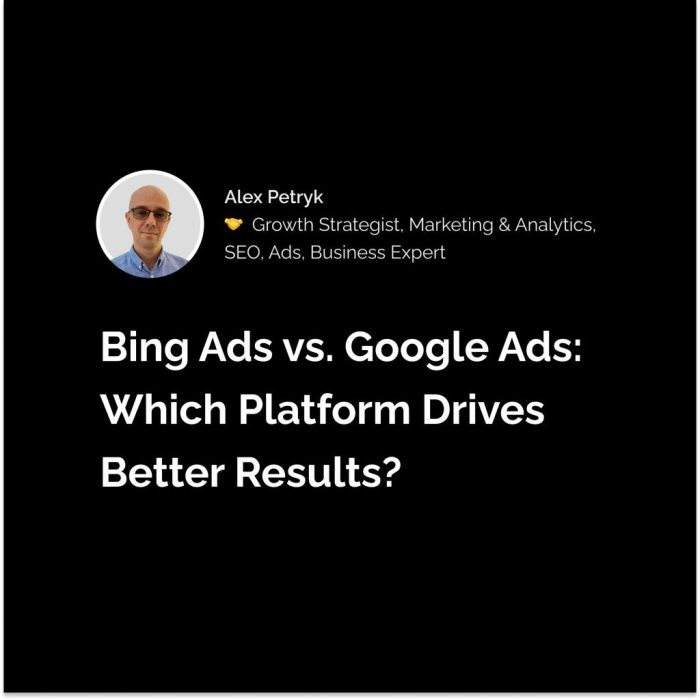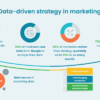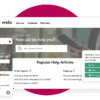When to use Bing Ads vs Google Ads? This crucial question often stumps marketers. Choosing the right platform hinges on your business objectives, target audience, and budget. Bing and Google each have unique strengths, and understanding these differences is key to campaign success. This guide dives deep into the factors that influence your choice, from audience targeting to pricing models, equipping you with the knowledge to maximize your ROI.
Different businesses have different needs. A brand focused on e-commerce sales might prioritize Google Ads’ extensive reach, while a local business targeting a specific demographic might find Bing Ads more cost-effective. We’ll examine these scenarios and more, providing a clear comparison of each platform’s strengths and weaknesses across various business goals.
Defining the Objectives
Choosing between Bing Ads and Google Ads hinges significantly on clearly defined business objectives. A well-defined objective acts as a compass, guiding the selection process and ensuring the chosen platform aligns perfectly with the desired outcomes. Understanding the nuances of each platform’s strengths and weaknesses in relation to these objectives is critical for maximizing ROI.Different business goals will favor different platforms.
A company aiming for broad brand awareness might find Bing Ads’ unique features advantageous, while a direct-response retailer focusing on immediate sales conversions will likely prioritize Google Ads. A balanced approach often involves a combination of both, tailoring campaigns to specific objectives within the overall strategy.
Different Business Goals
Understanding the distinct goals driving advertising campaigns is paramount. These goals range from generating leads and driving sales to building brand recognition and increasing website traffic. Each goal demands a different strategy, and the choice of platform should reflect this.
- Brand Awareness: Building a strong brand presence is crucial for long-term success. Bing Ads, with its emphasis on vertical search and display advertising, often proves effective in reaching a broader audience beyond the core Google search demographic. This broader reach can be particularly beneficial for niche businesses seeking to expand their market share.
- Lead Generation: Acquiring qualified leads is a primary goal for many businesses. Both platforms excel in lead generation, but the specific targeting capabilities and cost-per-lead metrics may differ. Google Ads’ vast reach and sophisticated targeting tools are often favored for lead generation campaigns requiring high precision. Bing Ads, while having a smaller audience, might provide a more cost-effective way to reach a specific niche audience, particularly for certain industries.
- E-commerce Sales: Driving online sales is a critical objective for e-commerce businesses. Google Ads, with its robust shopping features and extensive product catalog management capabilities, is often the preferred choice for direct sales conversions. Bing Ads, though less dominant in e-commerce, can still offer targeted campaigns and potentially lower costs for some businesses, particularly those targeting specific demographics not as effectively reached through Google Ads.
Metrics for Success
Evaluating campaign performance requires a focus on key metrics. These metrics provide a clear picture of campaign effectiveness and platform suitability.
- Click-Through Rate (CTR): This metric measures the percentage of users who click on an ad after viewing it. A higher CTR indicates a more effective ad copy or targeting. Monitoring CTR helps identify areas for improvement.
- Conversion Rate: This measures the percentage of visitors who complete a desired action, such as making a purchase or filling out a form. High conversion rates are a strong indicator of successful campaigns. Conversion rate metrics provide crucial insights for refining campaigns and optimizing ad copy.
- Cost-Per-Click (CPC): This metric reflects the cost a business pays for each click on its ad. Lower CPCs typically translate to more cost-effective campaigns. Tracking CPC helps in budget management and efficient resource allocation.
Influencing Factors
Several factors contribute to the optimal choice of platform. These include the target audience, budget, and campaign goals.
| Business Goal | Bing Ads Strengths | Google Ads Strengths |
|---|---|---|
| Brand Awareness | Broader reach in vertical searches, potentially lower costs | Extensive reach, established brand recognition |
| Lead Generation | Niche targeting, potentially lower cost-per-lead | Sophisticated targeting tools, vast audience |
| E-commerce Sales | Targeted campaigns, potential lower costs | Shopping features, robust product catalog management |
Audience Targeting and Reach
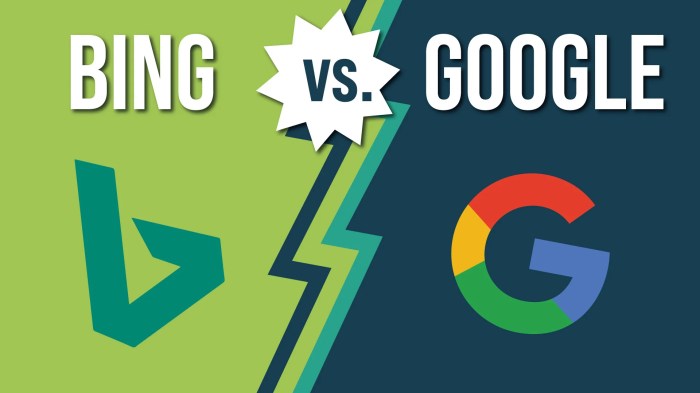
Understanding your target audience is crucial for any successful advertising campaign. Knowing where your ideal customers hang out online, what they’re interested in, and how they interact with brands is key to maximizing your return on investment. This section delves into the different audience targeting options offered by Bing Ads and Google Ads, examining their reach and visibility across various demographics and interests.Bing Ads and Google Ads both provide powerful tools for reaching specific audiences, but they cater to slightly different user bases and market segments.
Understanding these nuances will help you decide which platform best aligns with your business goals and target customer profile.
Bing Ads Audience Targeting Options
Bing Ads, while often overlooked, offers robust audience targeting options, especially for specific niches and smaller businesses. Its targeting capabilities are focused on delivering results for campaigns with well-defined, niche audiences. Bing’s user base tends to lean towards specific interests and behaviors, making it an effective channel for businesses aiming for precise targeting.
- Bing Ads utilizes demographic data, including age, gender, and location, to segment audiences. This allows advertisers to pinpoint specific customer groups within their geographic area.
- Interests and behaviors are also critical components of Bing’s targeting strategy. Advertisers can leverage this to reach users based on their online activities and preferences.
- Affinity targeting enables reaching users who are likely to be interested in particular products or services based on their online browsing history.
Google Ads Audience Targeting Options
Google Ads, with its massive user base, provides a broader reach but often requires more sophisticated targeting strategies to stand out from the competition. Google’s vast user base means it’s essential to refine your audience targeting to achieve optimal performance.
Deciding between Bing Ads and Google Ads depends heavily on your target audience and marketing goals. If you’re focusing on a specific niche, Bing Ads might be a more cost-effective option. However, for broader reach, Google Ads is usually the better choice. And remember, a crucial step in any online advertising strategy is ensuring your website is properly indexed.
A common issue is a redirect error, and you can troubleshoot these problems using Google Search Console, like in this helpful guide on google search console how to fix page with redirect. Ultimately, knowing how to use these tools will allow you to fine-tune your online presence and boost your return on investment in any ad campaign.
- Google Ads’s comprehensive audience targeting capabilities include detailed demographic data, enabling precise targeting based on factors like age, gender, income, and education level.
- Interests and behaviors are also crucial in Google Ads. This allows for reaching users based on their browsing history, online activities, and past purchases.
- Custom intent targeting enables reaching users based on specific search queries and interests.
- Remarketing allows advertisers to re-engage users who have previously interacted with their website or brand.
Reach and Visibility Comparison
While both platforms offer impressive reach, their visibility and user demographics differ. Google’s broader reach is due to its dominance in search, while Bing offers a more focused, niche reach for those seeking to target specific demographics.
| Feature | Bing Ads | Google Ads |
|---|---|---|
| User Base | Concentrated on specific niches and interests | Vast and diverse, encompassing a broad spectrum of interests |
| Demographics | More focused on specific demographics and locations | Comprehensive demographic data, enabling granular targeting |
| Interests | Targeted toward specific interests and behaviors | Comprehensive interest-based targeting, covering a wide range of topics |
| Reach | Generally lower than Google, but higher for niche targeting | Highest reach due to extensive user base |
| Visibility | Concentrated in search and specific interest areas | High visibility across the Google ecosystem |
Audience Segmentation and Targeting Tools, When to use bing ads vs google ads
Both platforms offer sophisticated tools for segmenting and targeting audiences.
- Bing Ads’s tools allow advertisers to segment audiences based on location, demographics, and interests. These tools can help pinpoint the right audience based on various factors.
- Google Ads provides detailed targeting options using demographics, interests, and behaviors. Advanced tools like custom audiences and remarketing lists further enhance targeting capabilities.
Campaign Management and Optimization
Mastering the art of campaign management is crucial for achieving your desired ROI on either Bing Ads or Google Ads. Effective campaign management involves not only setting up campaigns but also continuously monitoring, adjusting, and optimizing them for maximum performance. This process requires a deep understanding of the platforms’ functionalities, key performance indicators (KPIs), and best practices. A well-managed campaign will ensure your advertising budget is utilized efficiently, leading to a higher return on investment.Campaign management involves a multifaceted approach, including the setup, tracking, and analysis of campaign performance on both platforms.
By understanding the nuances of each platform and implementing best practices, advertisers can achieve significant improvements in their advertising results.
Setting Up and Managing Campaigns
Setting up a campaign on either platform involves similar steps, but the specific functionalities and user interfaces differ. Understanding these differences is essential for effective management. Both platforms provide tools for creating, targeting, and tracking campaigns. However, the level of automation and pre-built functionalities can vary. Google Ads generally offers a wider range of pre-built features, while Bing Ads may require more manual adjustments.
Key Performance Indicators (KPIs)
Successful campaign management hinges on tracking the right KPIs. These metrics provide insights into campaign performance and allow for data-driven adjustments. Essential KPIs include click-through rate (CTR), conversion rate, cost-per-click (CPC), cost-per-acquisition (CPA), and return on ad spend (ROAS). These metrics allow you to assess campaign effectiveness and make necessary adjustments to optimize results.
Platform Comparison: Ease of Use and Interface Design
Google Ads boasts a more comprehensive and user-friendly interface, often praised for its intuitive navigation and extensive automation options. Bing Ads, while offering a functional interface, may require more technical knowledge for certain advanced functionalities. Both platforms have robust reporting tools, but Google Ads often offers more readily available insights and visualizations. The choice between platforms often depends on the specific needs and technical expertise of the advertiser.
Basic Campaign Setup Steps
| Feature | Bing Ads | Google Ads ||—|—|—|| Campaign Creation | Select campaign goal, set budget, choose targeting options. | Define campaign objective, set budget, target audience demographics. || Targeting | Utilize location, demographics, s, and other criteria. | Leverage targeting, audience segments, and detailed targeting options. || Bidding | Choose bidding strategy (e.g., manual, automatic).
| Employ bidding strategies (e.g., maximize clicks, target CPA). || Ad Creation | Design compelling ad copy and landing page URL. | Create visually appealing ads with different ad formats. || Tracking | Implement conversion tracking for accurate results. | Utilize Google Analytics or other tracking tools to measure conversions.
|
Best Practices for Optimization
Consistent monitoring and analysis of campaign performance are vital. Regularly reviewing data, identifying areas for improvement, and making necessary adjustments are key.
- Continuous Monitoring: Regularly review campaign performance data, paying close attention to KPIs like CTR, conversion rates, and CPC.
- Research: Conduct thorough research to identify relevant and high-performing s. This ensures your ads reach the right audience.
- A/B Testing: Experiment with different ad copy, landing pages, and targeting options to identify what resonates best with your audience.
- Budget Allocation: Allocate your budget strategically across different campaigns and ad groups based on performance data. This ensures optimal resource allocation.
- Quality Score Optimization: Optimize ad quality scores by writing relevant and engaging ad copy and ensuring landing pages align with ad messaging.
Budget and Pricing Models
Choosing the right advertising platform often comes down to more than just campaign objectives and target audiences. A crucial factor is understanding the pricing models and how your budget will be allocated. Different platforms have distinct approaches to charging, impacting your return on investment and overall cost-effectiveness. This section delves into the specifics of Bing Ads and Google Ads pricing, offering insights into potential ROI and cost comparisons.
Pricing Models for Bing Ads and Google Ads
Bing Ads and Google Ads utilize different pricing models, reflecting their unique approaches to advertising. Bing Ads primarily employs a pay-per-click (PPC) model, where advertisers pay only when a user clicks on their ad. Google Ads, while also using PPC, incorporates a broader spectrum of pricing options, including pay-per-click, pay-per-thousand impressions (CPM), and others. These models influence the cost of running campaigns and the potential return on investment.
Budget Allocation Strategies
Budget allocation strategies for Bing Ads and Google Ads can vary significantly based on the specific goals and expected ROI. For example, a business prioritizing brand awareness might allocate a larger portion of their budget to Google Ads due to its wider reach. Conversely, a company focused on direct sales conversions might lean towards Bing Ads for potentially lower CPCs and higher conversion rates.
This strategic allocation requires careful consideration of the platform’s strengths, weaknesses, and the specific business objectives.
Calculating Potential ROI
Calculating the potential return on investment (ROI) for campaigns on either platform requires a thorough understanding of the costs and expected outcomes. The formula for calculating ROI is simple: (Revenue Generated – Costs) / Costs
- For Bing Ads and Google Ads, this involves tracking clicks, conversions, and revenue generated through each campaign. Detailed analytics dashboards on both platforms provide tools for evaluating the effectiveness of each campaign. Examples of how this works in practice are plentiful: a business that runs a highly targeted Bing Ads campaign might see a higher conversion rate and lower cost per conversion, leading to a better ROI.
Conversely, a Google Ads campaign focused on broader reach might generate more initial leads, but at a higher cost per click.
Factors Influencing Cost-Effectiveness
Several factors influence the cost-effectiveness of Bing Ads and Google Ads. These include competition, ad quality, landing page optimization, and the targeting strategy employed. On Bing Ads, a smaller, niche market might lead to lower competition and, subsequently, lower costs. Google Ads, with its massive user base, can have higher competition, resulting in potentially higher costs for similar s.
Ad quality, landing page optimization, and audience targeting directly impact the cost-effectiveness of both platforms.
Comparison of Pricing Structures
| Feature | Bing Ads | Google Ads |
|---|---|---|
| Pricing Model | PPC (Pay-per-Click) | PPC, CPM (Cost-per-Thousand Impressions), and others |
| Competition | Generally lower than Google Ads, especially for niche s. | Higher competition, especially for popular and highly searched s. |
| Average CPC (Cost-per-Click) | Potentially lower than Google Ads for comparable s. | Potentially higher than Bing Ads for comparable s. |
| Campaign Management Tools | Comprehensive set of tools for managing and optimizing campaigns. | Comprehensive set of tools for managing and optimizing campaigns. |
| Reach | Smaller than Google Ads, but can be highly targeted to specific audiences. | Vast reach and wider audience targeting options. |
| Overall Cost | Potential for lower costs, especially for niche s. | Potential for higher costs due to higher competition. |
The table above highlights key differences in pricing structures between the two platforms, providing a snapshot of the potential costs associated with each.
Ad Creative and Formats: When To Use Bing Ads Vs Google Ads
Crafting compelling ad creatives is crucial for driving results on both Bing Ads and Google Ads. The right visuals, concise copy, and effective ad formats can significantly impact click-through rates and conversions. Understanding the nuances of each platform’s ad formats and best practices is essential for maximizing your advertising spend.
Ad Types and Formats on Each Platform
Different ad formats cater to diverse advertising needs. Knowing which format suits your campaign is paramount. Bing Ads and Google Ads both offer a range of ad types, each with its own strengths.
- Bing Ads primarily supports text-based ads, display ads, and search ads. These formats are ideal for targeting users actively searching for products or services related to your business. The platform also provides options for dynamic search ads (DSAs), which adapt to user queries in real-time, potentially increasing relevance and click-through rates. Bing Ads offers strong performance for businesses focusing on local searches.
- Google Ads, being a broader platform, provides a wider array of ad formats. Beyond search ads, Google Ads supports display ads (including responsive display ads), video ads, shopping ads, and app promotion ads. These diverse options allow for a more targeted approach to reaching a wider audience, enabling businesses to engage users in various stages of the buying journey.
The platform’s advanced targeting capabilities also make it suitable for highly granular audience segmentation.
Effective Ad Creatives for Bing Ads
Bing Ads thrives on concise and clear messaging. For example, a text ad emphasizing a limited-time offer or a strong call to action (“Shop Now”) can perform exceptionally well. A visually appealing display ad featuring high-quality images or videos of your products can also capture attention and drive engagement. High-quality product images are vital to ensure the ad reflects the actual product, boosting customer trust.
Effective Ad Creatives for Google Ads
Google Ads benefits from visually engaging ad creatives. A compelling image or video is essential to capture attention in the sea of ads. Use high-quality images and videos that accurately reflect your products or services. Responsive display ads, which automatically adjust to different screen sizes, are particularly useful for broader reach. Consider using eye-catching visuals and clear calls to action within your ads.
Visual Appeal and Attention-Grabbing Techniques
Creating visually appealing ads is crucial for both platforms. High-quality images and videos are vital for showcasing your products or services effectively. Consider using vibrant colors, clear typography, and concise design elements to maintain user engagement. The visual appeal of your ad should align with your brand identity.
Ad Copywriting Best Practices
Crafting compelling ad copy is essential. Clear and concise language that highlights the unique selling points of your products or services is crucial. Use s naturally within your copy to increase visibility and relevance to user searches. A compelling call to action is necessary to guide users toward the desired action, such as visiting your website or making a purchase.
Ad Formats Supported by Each Platform
| Ad Format | Bing Ads | Google Ads |
|---|---|---|
| Search Ads | Yes | Yes |
| Display Ads | Yes | Yes |
| Shopping Ads | No | Yes |
| Video Ads | Limited | Yes |
| App Promotion Ads | No | Yes |
Each platform supports a variety of ad formats tailored to different objectives. Choosing the appropriate format ensures your ad resonates with your target audience and maximizes your campaign’s effectiveness.
Platform Features and Integrations
Choosing between Bing Ads and Google Ads often comes down to more than just targeting. Understanding the unique features and integrations available on each platform is crucial for maximizing your advertising ROI. This section delves into the specific tools and functionalities offered by each platform, their compatibility with other marketing technologies, and the level of support provided to advertisers.Platform-specific features and integrations are not just about the ads themselves; they encompass the entire marketing ecosystem.
Having access to powerful tools and seamless integrations can significantly streamline your campaigns and improve performance.
Bing Ads Unique Features
Bing Ads, while often overshadowed by Google Ads, boasts a range of distinct features. These unique tools can be particularly advantageous for advertisers seeking specific performance goals.
- Enhanced Targeting Options: Bing Ads offers advanced targeting options that leverage Bing’s search engine and partner websites. This enables advertisers to reach a wider audience with more precision compared to basic targeting. For instance, advertisers can utilize demographic and interest-based targeting that complements their existing strategies. This allows for a more holistic approach to audience segmentation, making campaigns more efficient.
Figuring out whether Bing Ads or Google Ads is the better choice often comes down to your specific business goals. If you’re looking to build a strong online presence, consider how content marketing can help, like creating valuable blog posts and engaging social media content. how can content marketing help a business This approach can attract organic traffic and establish your brand, which can be a huge benefit if you’re trying to reach a specific niche audience.
Ultimately, choosing the right platform depends on your budget, target audience, and overall marketing strategy. Bing Ads might be a more cost-effective option for smaller businesses, while Google Ads offers a broader reach.
- Integration with Microsoft Advertising Suite: Bing Ads is tightly integrated with other Microsoft advertising platforms, allowing for a more comprehensive approach to advertising campaigns. This includes seamless integration with other Microsoft marketing solutions, enhancing the overall marketing strategy.
- Data Insights and Reporting: Bing Ads provides detailed reporting and analytics tools, allowing advertisers to track campaign performance and identify areas for improvement. The platform offers comprehensive insights into campaign effectiveness, enabling data-driven adjustments to maximize ROI. For example, real-time data on ad impressions, clicks, and conversions allows for rapid identification of underperforming campaigns and quick adjustments.
Google Ads Unique Features
Google Ads, the market leader, boasts a vast array of features and integrations. Its dominance is largely due to its extensive reach and comprehensive ecosystem.
- Extensive Reach and Data: Google Ads leverages Google’s vast network of websites and applications, providing unparalleled reach to potential customers. This widespread visibility often translates to higher conversion rates and a larger pool of potential customers, leading to significant campaign growth. Google’s vast dataset allows for incredibly granular audience targeting.
- Diverse Advertising Formats: Google Ads offers a wider array of ad formats compared to Bing Ads, from search ads to display ads, video ads, and more. This versatility allows for greater creativity and flexibility in advertising campaigns, tailoring to various advertising goals and targeting approaches.
- Robust Support and Resources: Google Ads provides a wealth of resources, including extensive documentation, tutorials, and support forums. This comprehensive support system enables advertisers to easily navigate the platform and effectively manage their campaigns. This strong support system is a key factor in helping businesses optimize their marketing campaigns.
Integration Options and Platform Support
Both platforms offer integrations with other marketing tools and platforms. The level of support and ease of integration vary depending on the chosen tools.
Choosing between Bing Ads and Google Ads often hinges on your target audience and marketing strategy. For businesses focusing on B2B and moving toward account-based marketing (ABM), like b2b moving toward account based marketing abm , Bing Ads might offer a more cost-effective approach for reaching niche audiences. However, Google Ads’ broader reach and established user base still make it a strong contender, especially for generalist B2C campaigns.
| Platform | Integration Options | Support & Resources | Ease of Integration |
|---|---|---|---|
| Bing Ads | Microsoft Advertising Suite, CRM systems (limited options) | Good documentation, online forums, but less extensive than Google Ads | Medium, some technical expertise may be required for complex integrations |
| Google Ads | Extensive integrations with various marketing tools (e.g., CRM systems, analytics platforms, marketing automation tools) | Excellent documentation, extensive support resources, online communities | High, generally easy to integrate with other tools |
Data Analysis and Reporting
Understanding the performance of your advertising campaigns is crucial for optimization and return on investment. Data analysis tools provide insights into what’s working, what’s not, and where you can improve. Detailed reporting features allow you to track key metrics and make data-driven decisions. This section dives into the data analysis and reporting capabilities of Bing Ads and Google Ads, empowering you to make informed choices.
Bing Ads Reporting
Bing Ads offers a comprehensive suite of reporting tools, enabling advertisers to monitor campaign performance and make necessary adjustments. These reports cover various aspects of the campaigns, including impressions, clicks, conversions, and cost-per-click (CPC). The platform provides a clear overview of the data, allowing for easy identification of trends and areas for improvement.
- Metrics Tracking: Bing Ads provides a wide range of metrics, including impressions, clicks, conversions, cost-per-click (CPC), and cost-per-acquisition (CPA). These metrics allow you to assess the effectiveness of your campaigns in driving desired outcomes.
- Data Visualization: Bing Ads presents data in various formats, including charts and tables. These visual representations aid in understanding the performance trends and patterns within your campaigns.
- Customizable Reports: Users can create custom reports to focus on specific metrics and timeframes. This allows for a deep dive into campaign performance tailored to specific needs.
Google Ads Reporting
Google Ads provides a robust reporting system that goes beyond basic metrics. It offers in-depth analysis tools to understand the performance of different ad groups, s, and campaigns. Data visualizations and customizable reports allow for targeted improvements.
- Extensive Reporting Options: Google Ads offers various reporting options, including detailed breakdowns of campaign performance, performance, and conversion tracking. This extensive data allows for granular analysis.
- Performance Tracking: The platform tracks key metrics like clicks, impressions, conversions, cost-per-click (CPC), and return on ad spend (ROAS). This comprehensive tracking helps assess the effectiveness of campaigns and identify areas for improvement.
- Automated Reporting: Google Ads allows for automated reporting schedules, enabling regular performance monitoring and data analysis without manual intervention. This feature streamlines the process and keeps you updated on campaign performance.
Comparing Data Visualization and Reporting Features
The following table summarizes the key data visualization and reporting features of Bing Ads and Google Ads:
| Feature | Bing Ads | Google Ads |
|---|---|---|
| Metrics Tracking | Impressions, clicks, conversions, CPC, CPA | Impressions, clicks, conversions, CPC, CPA, ROAS |
| Data Visualization | Charts, tables, intuitive dashboards | Interactive dashboards, charts, graphs, detailed breakdowns |
| Customizable Reports | Yes, with limited options | Yes, extensive customization options |
| Automated Reporting | Limited | Extensive, with scheduling and email alerts |
Optimizing Campaigns Using Data
Analyzing data from both platforms helps you identify areas for improvement. For example, if a particular is underperforming in Google Ads, you can adjust the bidding strategy or refine the targeting parameters. In Bing Ads, if a specific ad group is not generating conversions, you might need to revise the ad copy or landing page experience.
Final Summary
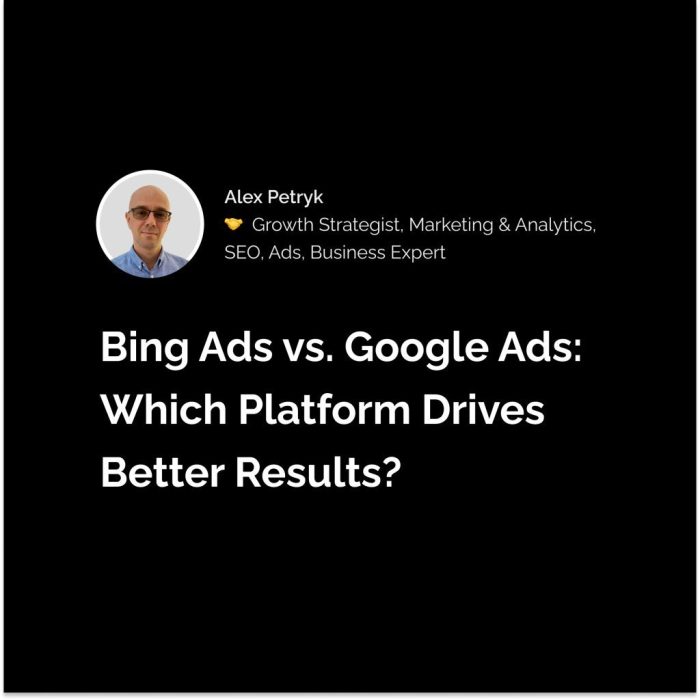
Ultimately, deciding between Bing Ads and Google Ads requires careful consideration of your specific needs. By evaluating your target audience, budget, and campaign objectives, you can select the platform best suited for your business. This guide provides a comprehensive overview to help you make an informed decision and maximize your advertising ROI. Remember to track your results closely, and adjust your strategy as needed.
The platform that best suits you today may not be the best choice tomorrow.

